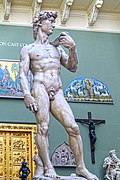- Piazzale Michelangelo, Florence
- Victoria and Albert Museum, London
- Langelinie Promenade, Copenhagen
- Avenue du Prado, Marseille (1903)
This article needs additional citations for verification .(June 2021) |

Michelangelo's David have been made replicas for numerous times, in plaster, imitation marble, fibreglass, snow, and other materials. [1] There are many full-sized replicas of the statue around the world, perhaps the most prominent being the one in the original's position in the Piazza della Signoria in Florence, Italy, placed there in 1910. The original sculpture was moved indoors in 1873 to the Accademia Gallery in Florence, where it attracts many visitors. Others were made for study at art academies in the late nineteenth century and later, while the statue has also been replicated for various commercial reasons or as artistic statements in their own right. Smaller replicas are often considered kitsch. [2]









